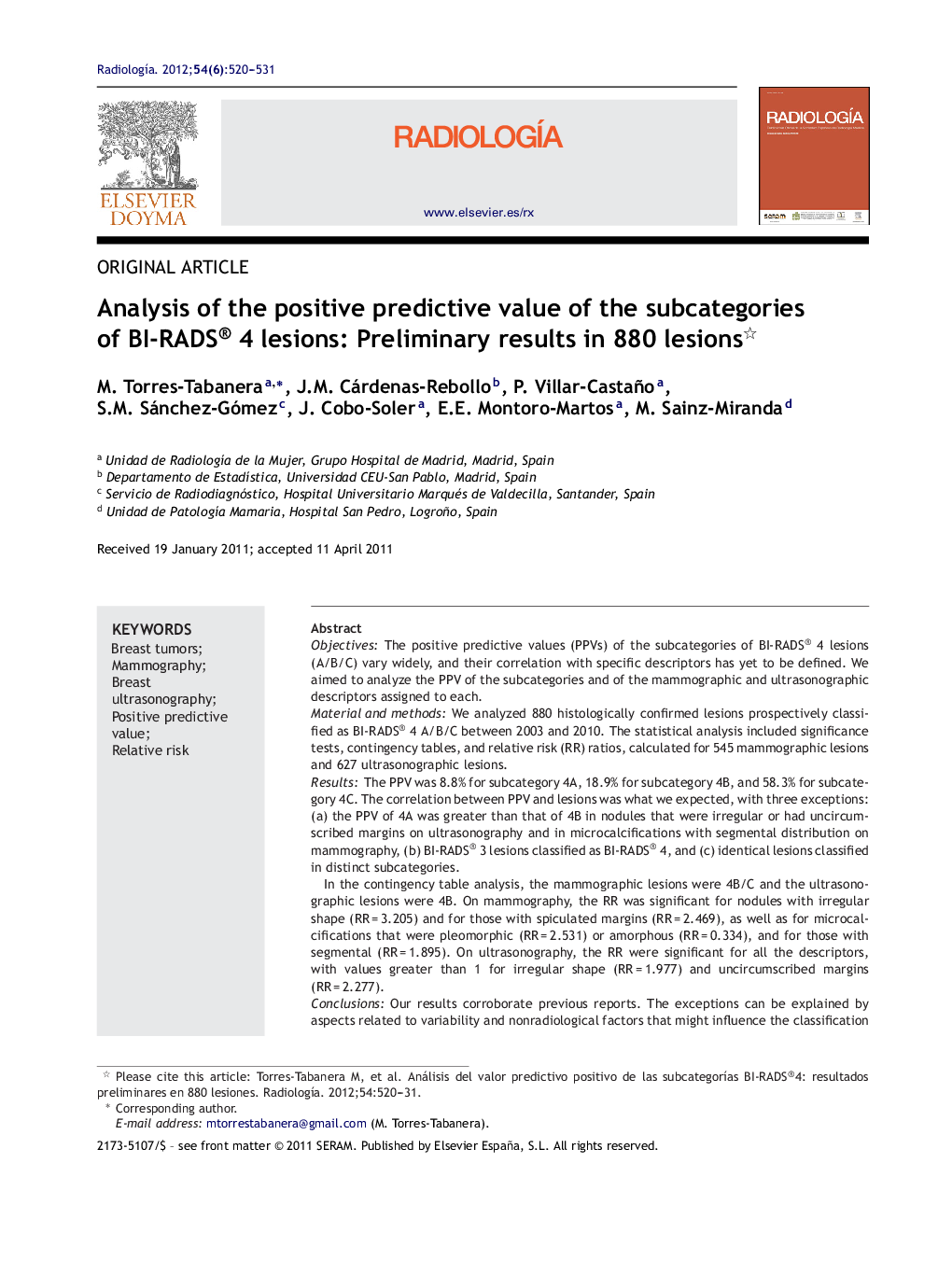| Article ID | Journal | Published Year | Pages | File Type |
|---|---|---|---|---|
| 4246551 | Radiología (English Edition) | 2012 | 12 Pages |
ObjectivesThe positive predictive values (PPVs) of the subcategories of BI-RADS® 4 lesions (A/B/C) vary widely, and their correlation with specific descriptors has yet to be defined. We aimed to analyze the PPV of the subcategories and of the mammographic and ultrasonographic descriptors assigned to each.Material and methodsWe analyzed 880 histologically confirmed lesions prospectively classified as BI-RADS® 4 A/B/C between 2003 and 2010. The statistical analysis included significance tests, contingency tables, and relative risk (RR) ratios, calculated for 545 mammographic lesions and 627 ultrasonographic lesions.ResultsThe PPV was 8.8% for subcategory 4A, 18.9% for subcategory 4B, and 58.3% for subcategory 4C. The correlation between PPV and lesions was what we expected, with three exceptions: (a) the PPV of 4A was greater than that of 4B in nodules that were irregular or had uncircumscribed margins on ultrasonography and in microcalcifications with segmental distribution on mammography, (b) BI-RADS® 3 lesions classified as BI-RADS® 4, and (c) identical lesions classified in distinct subcategories.In the contingency table analysis, the mammographic lesions were 4B/C and the ultrasonographic lesions were 4B. On mammography, the RR was significant for nodules with irregular shape (RR = 3.205) and for those with spiculated margins (RR = 2.469), as well as for microcalcifications that were pleomorphic (RR = 2.531) or amorphous (RR = 0.334), and for those with segmental (RR = 1.895). On ultrasonography, the RR were significant for all the descriptors, with values greater than 1 for irregular shape (RR = 1.977) and uncircumscribed margins (RR = 2.277).ConclusionsOur results corroborate previous reports. The exceptions can be explained by aspects related to variability and nonradiological factors that might influence the classification and PPV. Mathematical models should be developed to enable the objective classification and these should include factors not related to imaging.
ResumenObjetivosLas subcategorías BI-RADS®4A/B/C comprenden amplios rangos de valores predictivos positivos (VPP) y no se ha definido su correlación con descriptores específicos. Nuestro objetivo es analizar el VPP de las subcategorías y los descriptores asignados a ellas en lesiones mamográficas y ecográficas.Material y métodoAnalizamos 880 lesiones confirmadas histológicamente y subclasificadas prospectivamente como BI-RADS®4A/B/C entre 2003-2010. El estudio estadístico incluyó pruebas de significación, tablas de contingencia y estudio de riesgos relativos (RR) sobre 545 lesiones mamográficas y 627 ecográficas.ResultadosLos VPP por subcategoría fueron 8,8%-4A, 18,9%-4B y 58,3%-4C. La correlación entre VPP y lesiones fue la esperada, excepto: VPP 4A > 4B en nódulos ecográficos irregulares/márgenes no circunscritos y microcalcificaciones con distribución segmentaria, asignación de BI-RADS®4 a lesiones BI-RADS®3 y consideración de lesiones idénticas en distintas subcategorías.En el estudio por tablas de contingencia, las lesiones mamográficas estuvieron en rangos de 4B/C y las ecográficas en 4B. Los RR fueron significativos en nódulos mamográficos para morfología irregular (RR = 3,205) y márgenes espiculados (RR = 2,469), y para microcalcificaciones pleomórficas (RR = 2,531), amorfas (RR = 0,334) y distribución segmentaria (RR = 1,895). En ecografía, los RR fueron significativos en todos los descriptores, con valores mayores de 1 en morfología irregular (RR = 1,977) y márgenes no circunscritos (RR = 2,277).ConclusionesNuestros resultados concuerdan con los publicados. Las excepciones encontradas pueden justificarse por aspectos relacionados con la variabilidad y factores no radiológicos con posible influencia en la categorización y VPP. Es necesario elaborar modelos matemáticos que permitan la categorización objetiva e incluyan factores no relacionados con la imagen.
